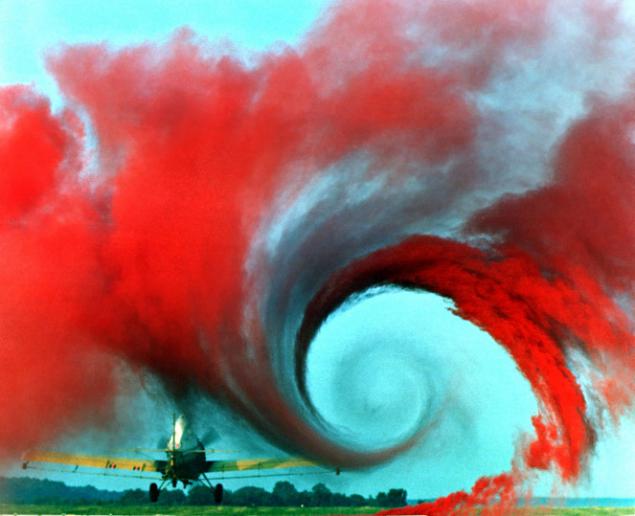893
Notorious turbulence
Turbulence afraid most of the passengers airliners. It's hard to keep cool when the plane "jumps" up and down, and anxious "waves" wings. "Buffeting" represents a great danger to people than to machines.

1. Turbulence does not lead to a catastrophe
Despite the terrible reputation of the killer of aircraft turbulence rarely leads to disaster. Over 120 years of aviation in the world, there was not a single case aviakrusheniya, the cause of which would be turbulence. In fact, the turbulence for the aircraft, the same thing that the bumps on the road to the car. The plane shakes due to the difference in the temperature of the ascending and descending air currents. And the zone of turbulence are rarely a surprise for the pilots. They are working on a route in advance before the flight and know all the ways to get around and out of dangerous areas.
So, according to aviation psychologist Alexei Gervashema turbulence - not a question of the safety of passengers, and the question of comfort. But sometimes strong turbulence can cause considerable damage - due to unexpected strong shaking, people went for a walk through the cabin, could be seriously affected. There were cases when, during turbulence open shelves with hand luggage and from there directly to the passengers fell all valid 13 kilograms of hand luggage.
2. Animals used turbulence
Some animals have learned to benefit from the turbulence, receiving energy from the incoming flow. For this purpose, they have a particular body structure, designed to disrupt the surface waves which are formed during the motion stroke of the wing or tail and consume a lot of energy. For example, a sharp tip of the tail is always that the size of waves formed on the end of a minimum. When a bird flapping flight artificially cause disruption of the boundary layer, creating the turbulence lift.
3. The most dangerous turbulence
Not all areas of turbulence can be determined in advance. They can occur not only in the clouds, but in a clear sky with excellent visibility, where weather radar will not be able to catch them coming. This so-called turbulence clear sky, which often occurs during flight at a height of 5-6 kilometers. Its main danger lies precisely in its unpredictability - the crew almost no time to warn passengers to return to their seats. Significantly, the majority of cases just in time for clear air turbulence (about 750 cases per year).
4. A method for controlling
When the plane gets into a zone of turbulence, it seems that the flight continues at the same pace and the pilot does not do anything to reduce shaking a little bit. That's not it. The pilots in the event of turbulence is a completely clear instructions. For example, aircraft velocity immediately decreases to reduce the resistance. The same thing happens during the boat ride - at high speed it throws on the waves, with small fluctuations hardly felt.
5. Rescue lasers
Perhaps the next generation of aircraft will be able to completely avoid areas of turbulence. Engineers German Aerospace Center perform tests ultraviolet lasers that can instantly analyze data on the reflected molecules of oxygen and nitrogen, and pre-determine the zone of turbulence, in particular turbulence clear sky. One has only to hope that scientists will succeed in its latest developments, since according to the latest projections, the number of cases of clear sky turbulence can increase dramatically by the middle of the XXI century, due to global warming.

1. Turbulence does not lead to a catastrophe
Despite the terrible reputation of the killer of aircraft turbulence rarely leads to disaster. Over 120 years of aviation in the world, there was not a single case aviakrusheniya, the cause of which would be turbulence. In fact, the turbulence for the aircraft, the same thing that the bumps on the road to the car. The plane shakes due to the difference in the temperature of the ascending and descending air currents. And the zone of turbulence are rarely a surprise for the pilots. They are working on a route in advance before the flight and know all the ways to get around and out of dangerous areas.
So, according to aviation psychologist Alexei Gervashema turbulence - not a question of the safety of passengers, and the question of comfort. But sometimes strong turbulence can cause considerable damage - due to unexpected strong shaking, people went for a walk through the cabin, could be seriously affected. There were cases when, during turbulence open shelves with hand luggage and from there directly to the passengers fell all valid 13 kilograms of hand luggage.
2. Animals used turbulence
Some animals have learned to benefit from the turbulence, receiving energy from the incoming flow. For this purpose, they have a particular body structure, designed to disrupt the surface waves which are formed during the motion stroke of the wing or tail and consume a lot of energy. For example, a sharp tip of the tail is always that the size of waves formed on the end of a minimum. When a bird flapping flight artificially cause disruption of the boundary layer, creating the turbulence lift.
3. The most dangerous turbulence
Not all areas of turbulence can be determined in advance. They can occur not only in the clouds, but in a clear sky with excellent visibility, where weather radar will not be able to catch them coming. This so-called turbulence clear sky, which often occurs during flight at a height of 5-6 kilometers. Its main danger lies precisely in its unpredictability - the crew almost no time to warn passengers to return to their seats. Significantly, the majority of cases just in time for clear air turbulence (about 750 cases per year).
4. A method for controlling
When the plane gets into a zone of turbulence, it seems that the flight continues at the same pace and the pilot does not do anything to reduce shaking a little bit. That's not it. The pilots in the event of turbulence is a completely clear instructions. For example, aircraft velocity immediately decreases to reduce the resistance. The same thing happens during the boat ride - at high speed it throws on the waves, with small fluctuations hardly felt.
5. Rescue lasers
Perhaps the next generation of aircraft will be able to completely avoid areas of turbulence. Engineers German Aerospace Center perform tests ultraviolet lasers that can instantly analyze data on the reflected molecules of oxygen and nitrogen, and pre-determine the zone of turbulence, in particular turbulence clear sky. One has only to hope that scientists will succeed in its latest developments, since according to the latest projections, the number of cases of clear sky turbulence can increase dramatically by the middle of the XXI century, due to global warming.























